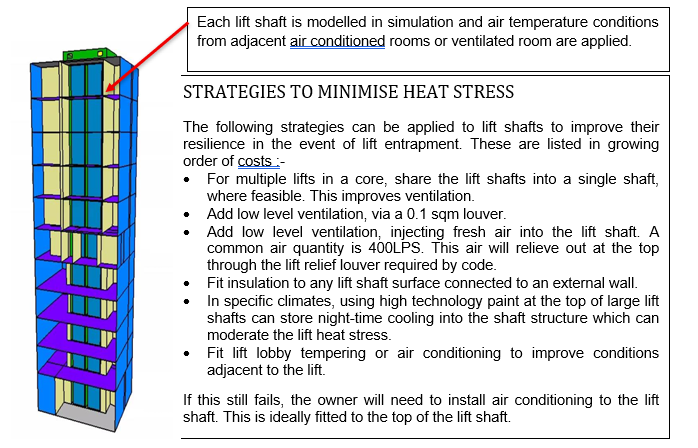This article provides guidance on managing the safety risks of lift entrapment, by interpreting Heat Risk Index Levels in relation to lift systems and human safety. It is particularly relevant for scenarios where individuals may be exposed to elevated temperatures in confined & unconditioned environments, such as during lift entrapments or where people are at risk e.g. pregnant women, the elderly or the unwell.
Heat Risk Levels – Practical Interpretation
SEED uses simulation modelling to determine whether satisfactory temperatures and heat risk levels can be maintained without air conditioning in the event of lift entrapment.
Previous editions of the building code & AS1735 specified in a draconian fashion when air conditioning needed to be applied to lifts, but, in more recent editions, this has been left to the lift manufacturer to specify. It is considered part of their ISO 7243 / ACGIH obligations for maintaining a safe place in the event of lift failure. The typical response to these standards is to use Heat Stress Threshold Limit Values. The table below portrays Heat Risk Levels and what they mean in a practical sense.
| Heat Risk Level | Risk Description | Practical Meaning |
| Level 0 – Green | Little to no risk. | Normal conditions; no specific heat-related precautions necessary. |
| Level 1 – Yellow | Minor risk. | Sensitive individuals may experience discomfort during prolonged exposure. |
| Level 2 – Orange | Moderate risk. | Most people may begin to experience heat stress without cooling or hydration. |
| Level 3 – Red | Major risk. | High likelihood of heat-related illness without access to cooling. |
| Level 4 – Magenta | Extreme risk. | Very high risk of serious heat-related illness or fatality. |
Governance Thresholds for Exposure
Using research from insurance companies, the following are “governance” targets for Heat Risk levels:
| Heat Risk Level | Governance Target
(Max Time Per Year) |
Practical Meaning |
| Level 0–1 (Low–Minor) | 80–95% of the time | Safe or manageable for most people. |
| Level 2 (Moderate) | ≤15% of the time | Acceptable with monitoring and mitigation. |
| Level 3 (Major) | ≤5% of the time | Tolerable short-term with mitigation in place. |
| Level 4 (Extreme) | <1% (ideal); <2% max | Should trigger design or operational review; 4% is extremely risky. |
SEED’s design practice is that the designs must be Level 4 for <2%. Ideally, we ought to achieve <1%, especially in high-risk spaces such as hospitals, aged care- and childcare- facilities.
When we conduct lift heat stress modelling, we use the synthetic climate file for 2050, based on a worst case scenario of RCP 8.5. However, if that scenario fails the 2% criteria, we test again using climate file 2030 and make a note to the owner that air conditioning may be a necessary upgrade at a later date.
Typical Lift Heat Stress Reporting
Assumptions for Heat Lift Stress modelling are typically as follows:

The SEED lift heat stress modelling will test every level, and it generates a % time for each heat index, for each level. The formula takes into account humidity and temperature levels. A typical result below:



Recent Comments